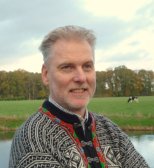This STAR interview features Maarten Bonnema of the Faculty of Engineering Technology. STAR is an acronym for Situation, Tasks, Actions, Results. Many stars in the UT firmament have an interesting story to tell. Maarten Bonnema’s focus is on systems engineering. Aligning and integrating subsystems is a key aspect of development processes.


Situation
What is or what was the situation (S) of your research or initiative?
Universities engage in groundbreaking research. This often entails exploring a particular area in great depth. Ultimately, the industrial sector wants to harness the power of those research results. For this to succeed, multiple disciplines need to work together. To manufacture an electric car, for example, you need battery technology, electric motors, control technology and power electronics, along with mechanical constructions to produce a vehicle that is stable and safe. Design, in the broadest sense of the word, is crucial to developing an attractive car suitable for production. It’s a challenge to strike an appealing balance between what the customer wants and needs and what is technically feasible, while not only taking into account all relevant disciplines but also weighing up the long-term effects. A company like ASML and other companies that develop and produce equipment for the semiconductor chain are ideally looking for people and ways to cooperate in a multidisciplinary way.
Tasks
Which tasks (T) were or are currently being dealt with?
The industry has a pressing need for the people and the approaches that make such trade-offs work. The ambition of the SEMD chair is to help meet this need through research and teaching. We want to make sure that this field – the field of systems engineering – is incorporated into the engineering curricula at the University of Twente. This can give students a real flavour of what the field has to offer, enabling them to make an informed decision on whether to pursue it as a career path. Our research focuses on communication between disciplines, and the design aspect of complex systems. Developers of the chips themselves are trained in Electrical Engineering. But it is also a task of UT to train people who understand the overall picture of high-tech equipment, can monitor the coherence and lead new developments at the system level.
Actions
What actions (A) are you working on and who is involved?
On the educational side, we run a Bachelor’s course for Electrical Engineering, Mechanical Engineering and Industrial Design Engineering. We also play an active part in all UT’s Engineering Doctorate programmes through the Systems Design and Engineering course (a collaboration with the faculties of Engineering Technology and Behavioural, Management and Social Sciences). We are also working on an Engineering Doctorate track that focuses on Systems Engineering and Architecting. Our aim with this track is to support professionals in their role as systems engineers as they progress through their career. This is particularly relevant for companies such as Thales, ASML, Philips and Canon Production Printing. In our research, we develop tools to create and capture a system design, preferably as simply as possible. The A3 Architecture Overview (A3AO) is a great example of this approach. We are currently working to expand this resource with interactivity and linkage to other information systems.
Results
What results (R) do you hope to achieve and how will they manifest themselves in society or within UT?
The aim is to link the exact and formal models already used in engineering with approaches geared towards making a complex system understandable to people from different backgrounds. This should facilitate communication between systems engineers, mechanical engineers, electrical engineers, industrial designers, manufacturing experts and more. This in turn will enable us to develop systems that fulfil needs without inflicting damage or causing unforeseen problems. In the Netherlands for example, we are strong in developing complex equipment for the chip industry. We must ensure that we remain strong in this field by embedding system design in several curricula.
Link to Maarten Bonnema’s inaugural lecture.






